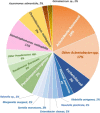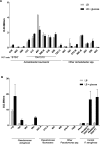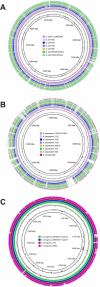Oral colonisation by antimicrobial-resistant Gram-negative bacteria among long-term care facility residents: prevalence, risk factors, and molecular epidemiology
- PMID: 32131899
- PMCID: PMC7057508
- DOI: 10.1186/s13756-020-0705-1
Oral colonisation by antimicrobial-resistant Gram-negative bacteria among long-term care facility residents: prevalence, risk factors, and molecular epidemiology
Abstract
Background: For residents of long-term care facilities (LTCFs), antimicrobial-resistant bacteria (ARB) are a risk factor, yet their oral colonisation, potentially leading to aspiration pneumonia, remains unclear. This study was undertaken to survey the prevalence, phenotypic characteristics, and molecular epidemiology of antimicrobial-resistant Gram-negative bacteria in the oral cavity of LTCF residents, and to analyse the risk factors for such carriers.
Methods: This study involved 98 residents of a LTCF in Hiroshima City, Japan, aged between 55 and 101 years. Oropharyngeal swabs were collected and plated on screening media for ESBL-producing and carbapenem-resistant bacteria; isolates were identified and tested for antibiotic susceptibility; biofilm formation was tested in vitro; identification of epidemic clones were pre-determined by PCR; resistance genes, sequence types, and whole-genome comparison of strains were conducted using draft genome sequences. Demographic data and clinical characterisations were collected and risk factors analysed.
Results: Fifty-four strains from 38% of the residents grew on screening media and comprised predominantly of Acinetobacter spp. (35%), Enterobacteriaceae spp. (22%), and Pseudomonas spp. (19%). All Escherichia coli isolates carried CTX-M-9 group and belonged to the phylogroup B2, O25:H4 ST131 fimH30 lineage. Six Acinetobacter baumannii isolates presented identical molecular characteristics and revealed more biofilm production than the others, strongly suggesting their clonal lineage. One Acinetobacter ursingii isolate displayed extensive resistance to various ß-lactams due to multiple acquired resistance genes. One Pseudomonas aeruginosa isolate showed exceptional resistance to all ß-lactams including carbapenems, aminoglycosides, and a new quinolone, showing a multidrug-resistant Pseudomonas aeruginosa (MDRP) phenotype and remarkable biofilm formation. Genome sequence analysis revealed this isolate was the blaIMP-1-positive clone ST235 in Japan. Strokes (cerebral infarction or cerebral haemorrhage) and percutaneous endoscopic gastrostomy tubes were recognised as risk factors for oral colonisation by ARB in the LTCF residents.
Conclusions: ARB, as defined by growth on screening agar plates, which carried mobile resistance genes or elements or conferred high biofilm formation, were already prevalent in the oral cavity of LTCF residents. Health-care workers involved in oral care should be aware of antimicrobial resistance and pay special attention to transmission prevention and infection control measures to diminish ARB or mobile resistance elements dissemination in LTCFs.
Keywords: Acinetobacter baumannii; Acinetobacter ursingii; Antimicrobial resistant bacteria; Carbapenemase; Escherichia coli; Extended-spectrum ß-lactamases; Oral colonisation; Pseudomonas aeruginosa; Risk factor analysis.
Conflict of interest statement
The authors declare that they have no competing interests.
Figures



References
-
- Bureau S. Ministry of Internal Affairs and Communications. Japan: Statistical Handbook of Japan; 2018.
-
- Flokas ME, Alevizakos M, Shehadeh F, Andreatos N, Mylonakis E. Extended-spectrum beta-lactamase-producing Enterobacteriaceae colonisation in long-term care facilities: a systematic review and meta-analysis. Int J Antimicrob Agents. 2017;50(5):649–656. doi: 10.1016/j.ijantimicag.2017.08.003. - DOI - PubMed
Publication types
MeSH terms
Substances
LinkOut - more resources
Full Text Sources
Medical
Miscellaneous

